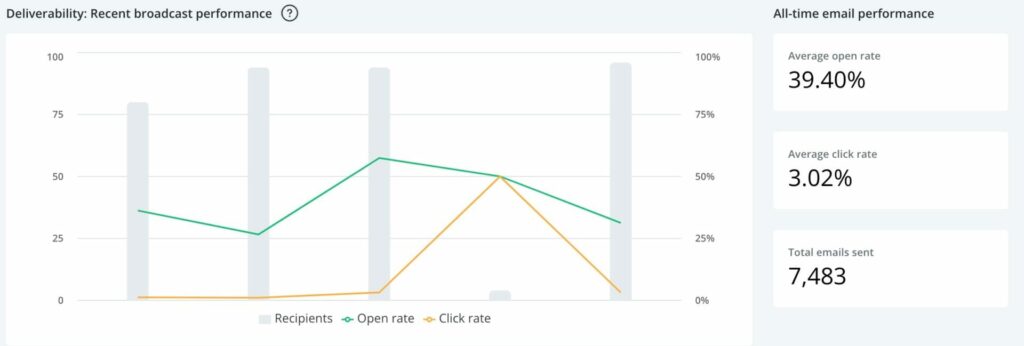
You’d think that after a decade as a copywriter (which is what I did before I became a mental health speaker), I’d have known better when it comes to writing headlines.
But last week I broke the cardinal rule of good copywriting. I sent out an article in my email newsletter, also published on my blog, with the headline: Do What Seth Godin Says. A terrible headline!
Before I get into the specifics of why it’s such a bad headline, let me give you some context.
This screenshot shows the stats for the overall performance of my email newsletter:

As you can see, that last email/blog post tanked. Indeed, until yesterday, it only had a 23.4% open rate. And my average open rate is 39.40% (if you’re not already getting my email newsletter, fill out this form and you’ll get it every Friday morning, plus a monthly reading list).
So What’s Wrong with Writing a Headline Like, “Do What Seth Godin Says”?
First, most people do not know who Seth Godin is. And if you don’t know who he is, why would you care what he said, and why would you read the email?
Second, the headline offers no benefit to the reader, explaining the value they’ll get because of investing their time in the article.
So how could I have rewritten the headline?
A Highly Effective Framework for Writing Headlines
I’m an AWAI-verified copywriter, and while I was studying with American Writers and Artists Inc, I learned a formula for creating powerful headlines, known as “The 4 U’s.”
Great headlines are:
- Urgent: They give your readers a potent reason to continue reading right now.
- Useful: The headline offers something that’s of value to the prospect.
- Unique: They suggest that what you’re offering differs from every competing product in the marketplace.
- Ultra-Specific: They avoid being vague.
The way to use The 4 U’s is that after you’ve come up with a list of potential headlines (how to do that is a topic for another time), then give each headline you’ve written a score for each one of The 4 U’s.
Example of a Bad Headline: 1/4
For example, let’s apply The 4 U’s to “Do What Seth Godin Says”:
- Urgent: No, so it gets a zero.
- Useful: No, so it gets a zero here, too.
- Unique: OK, I’ll give myself a point for this one. The idea of doing what Seth Godin says is certainly unique.
- Ultra-Specific: No, so another zero.
So my total score (just in case you haven’t already added it up) is one out of four.
Writing headlines, great headlines, means you want to aim for a score of three or four using The 4 U’s.
Example of a Good Headline: 3/4
Now let’s take another example and cross the fourth wall, examining The 4 U’s as they relate to the headline of this article: “Headlines That Work vs. Headlines That Don’t Work“:
- Urgent: No, so it gets a zero here.
- Useful: Yep, the headline promises that if you read the article, you’ll learn something useful for writing headlines. So I’ll give myself a point here.
- Unique: Yep, I Googled and while there are lots of “Headlines That Work” articles out there, mine has a unique headline. Go me! Also, scored a point here.
- Ultra-Specific: Yep. It promises you’ll learn about headlines that work and headlines that don’t work. So another point.
In total then, the headline of this article gets a score of three out of four points on The 4 U’s.
Now, I don’t actively seek copywriting work anymore. I’m having too much fun as a mental health speaker, and for that reason, I wrote this article to give events coordinators some tips on how to write effective subject headings for emails or headlines for other marketing materials they create to sell out their events.
That said, however, I am available on an extremely limited basis to work on copywriting projects that inspire me. As a copywriter, I’m now only available through Finda.Team, owned by the co-author of the book I’m currently editing, Joe Bellissimo.
My areas of specialisation are:
- Search Engine Optimisation (SEO) and Conversion Rate Optimisation (CRO) for websites, meaning that I get more people finding your site through Google and then when they get to your site, I turn them into leads so you can sell your products or services to them.
- Email marketing, such as sequences of emails so that you and your subscribers get to know each other and you’re able to target your products to them, and regular email newsletters so you stay at the “top of your prospect’s mind” when they think about businesses in your space.
Once you’re at the Finda.Team site, you’ll need to select a plan. If you have any difficulty getting set up, you can book a time with Joe and he’ll walk you through the process step-by-step.
OK, commercial over.
While I didn’t have as many people read last week’s email newsletter as usual, I had some people read it. One of these people was Roger Donnelley, CEO of the NDIS Provider, The SALT Foundation, where I work part-time as a digital marketing officer.
He wrote this lovely comment:
You are on the way to becoming a marketing genius and will not have to quote Seth anymore when posting.
Roger Donnelley, Founder & CEO, The SALT Foundation
So even though few people read the article, those who did got something out of it.
But if no one opens your email or clicks on the link to your blog post, what’s the point?
And my ultimate point is that that’s the exact purpose of a headline: to get your readers to keep reading.
So please share your thoughts and feedback in the comments. Did you agree with my analysis of the headlines from last week and this week? You’re welcome to disagree (respectfully, of course).

It takes a humble pro to publicly admit their mistake! We all goof up sometimes. It’s whether you get back up. Great analysis.
Thank you, Sarah. I’m glad my goof-up helped to remind you that we’re all human and it’s okay to make mistakes. It was a humbling experience for me and I’m grateful that I had the opportunity to learn from it.